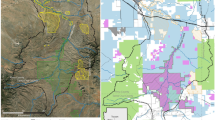Abstract
Natural ecosystems are characterized as dynamic systems that evolve through natural patterns of disturbance. Land managers can work within this system of natural disturbance by applying the concept of natural variability to their management plans. Land management challenges typically stem from infrequent and severe disturbances, like hurricanes, where resource management and conservation implications are a result of significant changes to a landscape’s patch dynamics. A frequently used strategy for overcoming these challenges is co-management. Since cooperative management requires collaboration across sectors, institutional and organization integration must be approached strategically. The importance of developing agreement on shared issues makes finding an effective consensus-building process critical. This study utilized the Delphi technique to develop consensus and identify the most significant post-hurricane impacts experienced by land managers following Hurricane Irma. We purposively selected a panel of 24 land managers that represented multiple sectors including county government, non-governmental organizations, and state and federal agencies. The study used a series of three online surveys, which were validated using an expert panel of evaluators, land managers, survey designers and natural resource educators. The panel achieved consensus on 5 post-hurricane impacts that they identified to have a significant effect on achieving their land management goals. The Delphi technique demonstrated to be a valuable process for gaining input from a diverse set of experts in the identification of agreed upon challenges to land management that resulted from extreme weather events. Our results serve as a foundation for discussions on management strategies to address extreme natural disturbances.


Similar content being viewed by others
References
Burgess H, Spangler B (2003) Consensus building. Retrieved from. https://www.beyondintractability.org/essay/consensus-building
Busing RT, White RD, Harmon ME, White PS (2009) Hurricane disturbance in a temperate deciduous forest: patch dynamics, tree mortality, and coarse woody detritus. Plant Ecol 201:351–363. https://doi.org/10.1007/s11258-008-9520-0
Crabbe M, Martinez E, Garcia C, Chub J, Castro L, Guy J (2009) Is capacity building important in policy development for sustainability? A case study using action plans for sustainable Marine Protected Areas in Belize. Soc Nat Res 23:181–190. https://doi.org/10.1080/08941920802409593
Dalkey NC (1972) The Delphi method: an experimental study of group opinion. In: Dalkey NC, Rourke DL, Lewis R, Snyder D (eds) Studies in the quality of life: Delphi and decision-making. Lexington books, Massachusetts, pp 13–54
De Urioste-Stone S, McLaughlin WJ, Sanyal N (2006) Using the Delphi technique to identify topics for a protected area co-management capacity building programme. Int J Rur Man 2:191–211. https://doi.org/10.1177/097300520600200204
Delp P, Thesen A, Motiwalla J, Seshadri N (1977) Delphi: system tools for project planning. National center for research in vocational education. Ohio State University, Columbus, OH.
Diamond IR, Grant RC, Feldman BM, Pencharz PB, Ling SC, Moore AM, Wales PW (2014) Defining consensus: a systematic review recommends methodologic criteria for reporting of Delphi studies. J Clin Epidem 67:401–409
Diaz J, Bardon R, Hazel D, Bruce J, Jayaratne KSU (2017a) The role of extension in the coordination of working partnerships among diverse stakeholder groups for the sustainability of rural landscapes. J Hum Sci Ext 5:53–70
Diaz J, Bardon R, Hazel D, Bruce J, Jayaratne KSU (2017b) Lessons learned for military-based partnerships for landscape-scale conservation: a case study of the North Carolina sentinel landscapes partnership. J Commun Eng Scholarsh 10:24–35
Diaz J, Webb S, Warner L, Monaghan P (2018) Barriers to community garden success: demonstrating framework for expert consensus to inform policy and practice. Urb For Urb Green 31:197–203
Geist MR (2010) Using the Delphi method to engage stakeholders: a comparison of two studies. Eval Program Plan 33:147–154
Hess GR, King TJ (2002) Planning open spaces for wildlife: I. Selecting focal species using a Delphi survey approach. Land Urban Plan 58:25–40. https://doi.org/10.1016/S0169-2046(01)00230-4
Hsu CC, Sandford BA (2007) The Delphi technique: making sense of consensus. Pract assess res eval 12:1–8. Retrieved from https://pareonline.net/getvn.asp?v=12&n=10
Innes JE, Booher DE (1999) Consensus building and complex adaptive systems. J Am Plan As 65:412–423. https://doi.org/10.1080/01944369908976071
Landres PB, Morgan P, Swanson FJ (1999) Overview of the use of natural variability concepts in managing ecological systems. Ecol Appl 9:1179–1188
Linstone HA, Turoff M (Eds.) (2002). The Delphi method: techniques and applications. New Jersey Institute of Technology, New Jersey Retrieved from https://inei.org.br/inovateca/
Malek C (2013) Collaborative Problem solving and consensus building. https://www.beyondintractability.org/coreknowledge/consensus-building
Mehnen N, Mose I, Strijke D (2013) The Delphi method as a useful tool to study governance and protected areas? Land Res 38:607–624. https://doi.org/10.1080/01426397.2012.690862
Menges ES, Deyrup MA (2001) Postfire survival in south Florida slash pine: interacting effects of fire intensity, fire season, vegetation, burn size, and bark beetles. Int J Wild Fire 10:53–63
Menges ES, Weekley CW, Clarke GL, Smith SA (2011) Effects of hurricanes on rare plant demography in fire-controlled ecosystems. Biotropica 43:450–458
Merriam SB (2009) Qualitative research: a guide to design and implementation. 3rd ed. Jossey-Bass, California
Meurant G (2012) The ecology of natural disturbance and patch dynamics. Academic press, Massachussets
Olsson P, Folke C, Berkes F (2004) Adaptive comanagement for building resilience in social–ecological systems. Environ manag 34:75–90. https://doi.org/10.1007/s00267-003-0101-7
Sousa WP (1984) The role of disturbance in natural communities. Ann rev ecol syst 15:353–391. Retrieved from https://www.jstor.org/stable/pdf/2096953.pdf
Warner LA (2015) Using the Delphi Technique to achieve Consensus: a tool for guiding extension programs. Retrieved from https://edis.ifas.ufl.edu/wc183
Wondolleck JM, Yaffee SL (2000) Making collaboration work: Lessons from innovation in natural resource management. Island Press, Washington DC
Author information
Authors and Affiliations
Corresponding author
Ethics declarations
Conflict of interest
The authors declare that they have no conflict of interest.
Additional information
Publisher's Note
Springer Nature remains neutral with regard to jurisdictional claims in published maps and institutional affiliations.
Rights and permissions
About this article
Cite this article
Diaz, J., Carnevale, S., Millett, C. et al. Evaluating post-hurricane impacts in co-management areas: a framework for expert consensus. Nat Hazards 103, 1905–1916 (2020). https://doi.org/10.1007/s11069-020-04061-1
Received:
Accepted:
Published:
Issue Date:
DOI: https://doi.org/10.1007/s11069-020-04061-1




